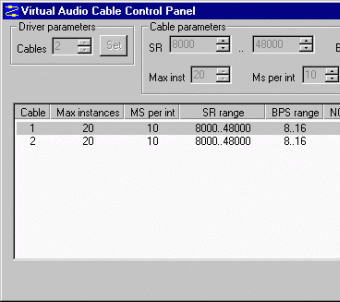Virtual Audio Cable
 | |
|
VAC 4 in Windows XP | |
| Developer(s) | Eugene Muzychenko |
|---|---|
| Stable release |
4.15
/ Dec 31, 2015 |
| Operating system | Microsoft Windows |
| Type | Audio software |
| License | Shareware |
| Website | Virtual Audio Cable |
Virtual Audio Cable is a WDM multimedia driver that allows a user to transfer audio streams from one application to another. Any application is able to send an audio stream to the input side of a "virtual cable" while a corresponding application can receive this stream from the output side. Since all transfers are made digitally, there is no loss in sound quality. VAC is the audio equivalent of a MIDI loopback device such as MultiMid or Hubi.[1] The latest package, VAC 4, includes 32-bit and 64-bit Windows Vista-compatible versions along with the previous Windows 2000/XP/2003.[1][2][3]
VAC is written entirely in object-oriented C++ and has no external dependencies.[4] Windows 98/ME/2000/XP versions consist of user-mode and kernel-mode components which are compiled from a single source file set.
If more than one application is sending audio through an output virtual cable, VAC is able to mix all of the streams together or create separate corresponding virtual input cables. Similarly, more than one application is able to receive audio from an input cable, whether it's sharing the same audio data with another target or receiving its own personal audio stream.[5] VAC is useful for recording an application's audio output in almost real time or transferring a sound stream to another application so it may process it. A person could use two or more software audio generators, synthesizers or sequencers to produce audio streams and send them to a VAC output cable and record the mixed stream from the VAC input cable using any type of recording software.
Because VAC routes audio streams in almost real time, it is able to be utilized in various manners. A person is capable of using VAC to record an output audio stream from an application that normally does not allow saving the audio to files.[6] A user could also manipulate VAC into recording conversations through Voice Over IP (VoIP) or Internet telephony applications such as Skype.
Features
- Windows XP/2003/Vista/7/8/8.1/10 platforms (32-Bit and 64-Bit)
- Native WDM/KS audio technology
- Up 256 Virtual Cables (Windows limits the number of Multimedia Extensions devices to 32)
- 1..20 milliseconds per interrupt
- 1..100 pin instances
- Supports almost any of fixed point PCM audio formats (Floating point formats are not supported)[3]
- Low sound latency with maximal interrupt frequency (1000Hz).
- Unlimited number of clients connected to each port
- Signal mixing between output port clients
- PCM format conversion
- Volume control features
- Channel scattering/gathering mode
- Watermark control technique to improve stream stability with unstable applications
- Stream buffering technique to partially compensate bad application buffering algorithms
- Control Panel application to dynamically configure cables
References
- 1 2 "Virtual Audio Cable 4". NTONYX. Retrieved 2011-08-10.
- ↑ "Virtual Audio Cable Home Page". Software.muzychenko.net. Retrieved 2011-08-10.
- 1 2 "Home » Virtual Audio Cable". Screenvirtuoso.com. Archived from the original on February 18, 2010. Retrieved 2011-08-10.
- ↑ Archived December 20, 2008, at the Wayback Machine.
- ↑ VAC UK, software-dungeon.co.uk. Retrieved August 2011 Archived December 19, 2008, at the Wayback Machine.
- ↑ "Download Virtual Audio Cable 4.14.0.6873 Free Trial - Connect several audio applications together in real time". Softpedia. 2014-06-05. Retrieved 2014-06-07.
External links
- Virtual Audio Cable Home Page
- Alternate Virtual Audio Cable software that runs on various operating systems.
